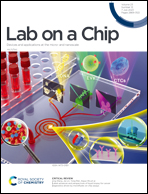Acrylic-based culture plate format perfusion device to establish liver endothelial–epithelial interface†
Abstract
Microphysiological Systems (MPSs) or organs-on-chips, are microfluidic devices used to model human physiology in vitro. Polydimethylsiloxane (PDMS) is the most widely used material for organs-on-chips due to its established fabrication methods and biocompatibility properties. However, non-specific binding of small molecules limits PDMS for drug screening applications. Here, we designed a novel acrylic-based MPS to capture the physiological architecture that is observed universally in tissues across the body: the endothelial–epithelial interface (EEI). To reconstruct the EEI biology, we designed a membrane-based chip that features endothelial cells on the underside of the membrane exposed to mechanical shear from the path of media flow, and epithelial cells on the opposite side of the membrane protected from flow, as they are in vivo. We used a liver model with a hepatic progenitor cell line and human umbilical vein endothelial cells to assess the biological efficacy of the MPS. We computationally modeled the physics that govern the function of perfusion through the MPS. Empirically, efficacy was measured by comparing differentiation of the hepatic progenitor cells between the MPS and 2D culture conditions. We demonstrated that the MPS significantly improved hepatocyte differentiation, increased extracellular protein transport, and raised hepatocyte sensitivity to drug treatment. Our results strongly suggest that physiological perfusion has a profound effect on proper hepatocyte function, and the modular chip design motivates opportunities for future study of multi-organ interactions.



 Please wait while we load your content...
Please wait while we load your content...